How much does a new patio cost? Expert budgeting advice
Whether you’re building one from scratch or want to upgrade an existing area, this is how much you should budget for patio costs
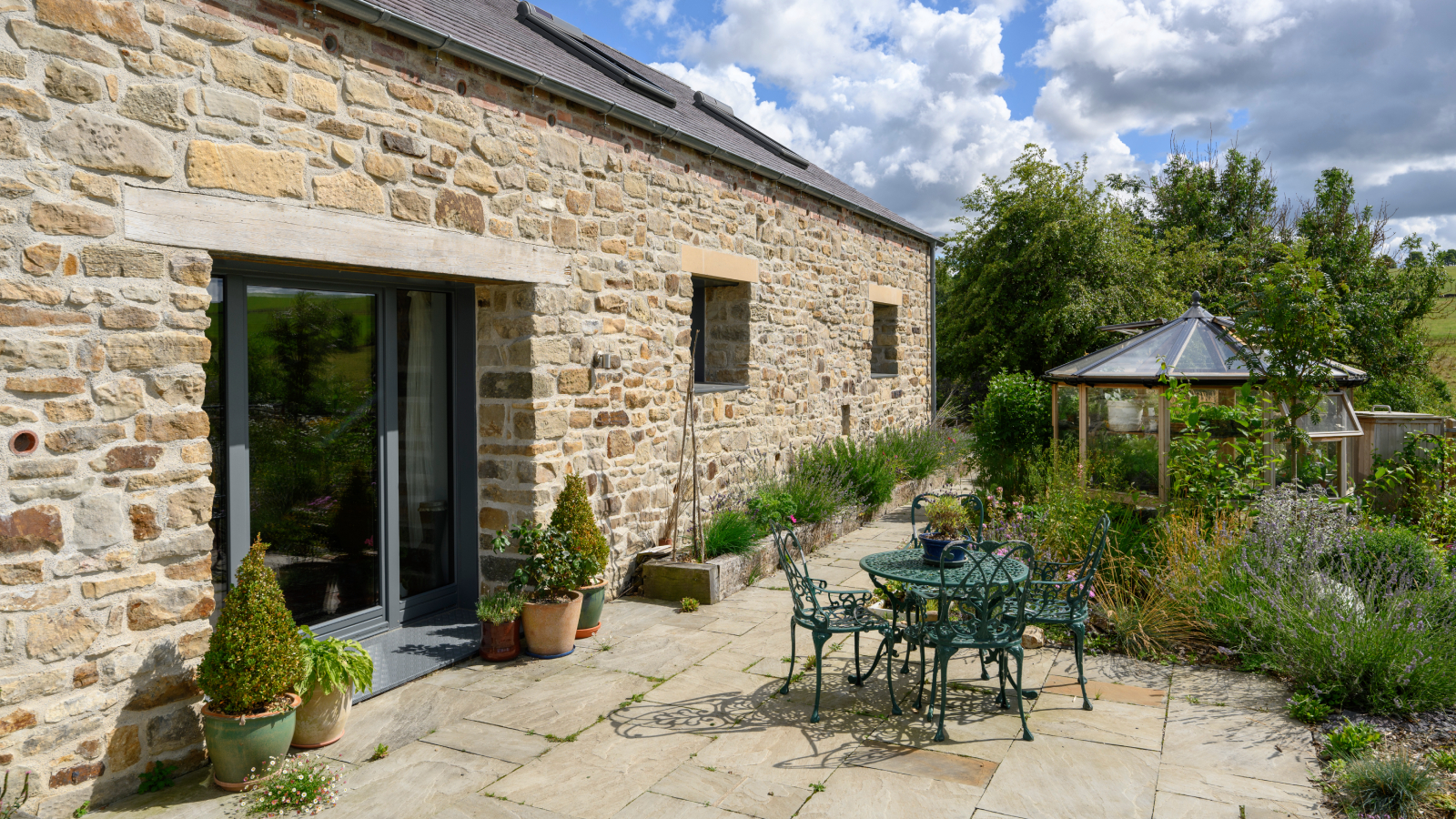
A well-designed patio frequently takes centre stage when picturing the ideal outdoor area. Whether it's used as a gathering place for weekend barbecues or as a peaceful hideaway for morning coffees and a good book, patio design ideas generally add another useable space to your garden - especially when the grass is wet or the ground too uneven for furniture
But as with any building project, there's always the nagging question of how much it will actually cost to realise that goal.
While each project will be dependant on size, style and materials, our expert quantity surveyor, Tim Phillips is on hand to take you through the costs and options involved to help turn your dream into reality.
How much are patio costs per m2?
Whether you're looking at a large outdoor entertaining zone or small patio ideas, a basic patio can be built for between £50 and £80/m2. However, the price can rise significantly to £150/m2 with more intricate designs, higher-quality materials, and added features like lighting, heating, or landscaping.
Understanding the complete picture of all the factors that can affect a patio's cost is essential to help you finalise your budget.
Factors affecting patio costs
1. New vs replacement
Building a brand-new patio typically requires more preparation and work than renovating an old one, especially if you need to remove outdated materials and undertake additional preparation.
2. Groundworks, construction and labour
If the general condition of the ground is poor, expenses may increase if the site needs a lot of excavation, levelling, or further ground work.
Proper drainage is also crucial for all patios in order to avoid water collecting as this can shorten the patio’s lifespan and create added maintenance. You may need to factor in Aco drainage, gravel joints and possibly a soakaway.
If your patio area has restricted access that makes delivering building supplies and plant more difficult, this will naturally impact your budget. Having to move items by hand will require additional manual labour. Being able to get a mini digger to the patio area, will be a lot cheaper and quicker than manual labour.
Location also comes into play with soil and spoil import and removal - both of which can be costly. Try to limit the amount of excess spoil and soil that you bring in or remove and instead, use any soil you remove to raise the level of the patio or for existing garden banks.
Finally, labour costs will vary depending on the level of skill required to carry out the installation, the availability of labour in the area and your location.
3. Material and design choices
The overall size of the patio has a direct bearing on the quantity of materials required and the work involved. Larger patios obviously cost more overall, since they require more labour and materials.
When it comes to materials, premium paving slabs or natural stone, are examples of high-end materials that can be more costly than regular concrete or inexpensive paving supplies. Costs can also increase if you opt for intricate designs, patterns or curves. Try and stick to industry standard sizes where possible as this will minimise wastage costs.
You'll also need to budget more if you are considering a raised patio or one that has steps to access another area of the garden. Creating retaining walls and steps can be more complicated and therefore more costly.
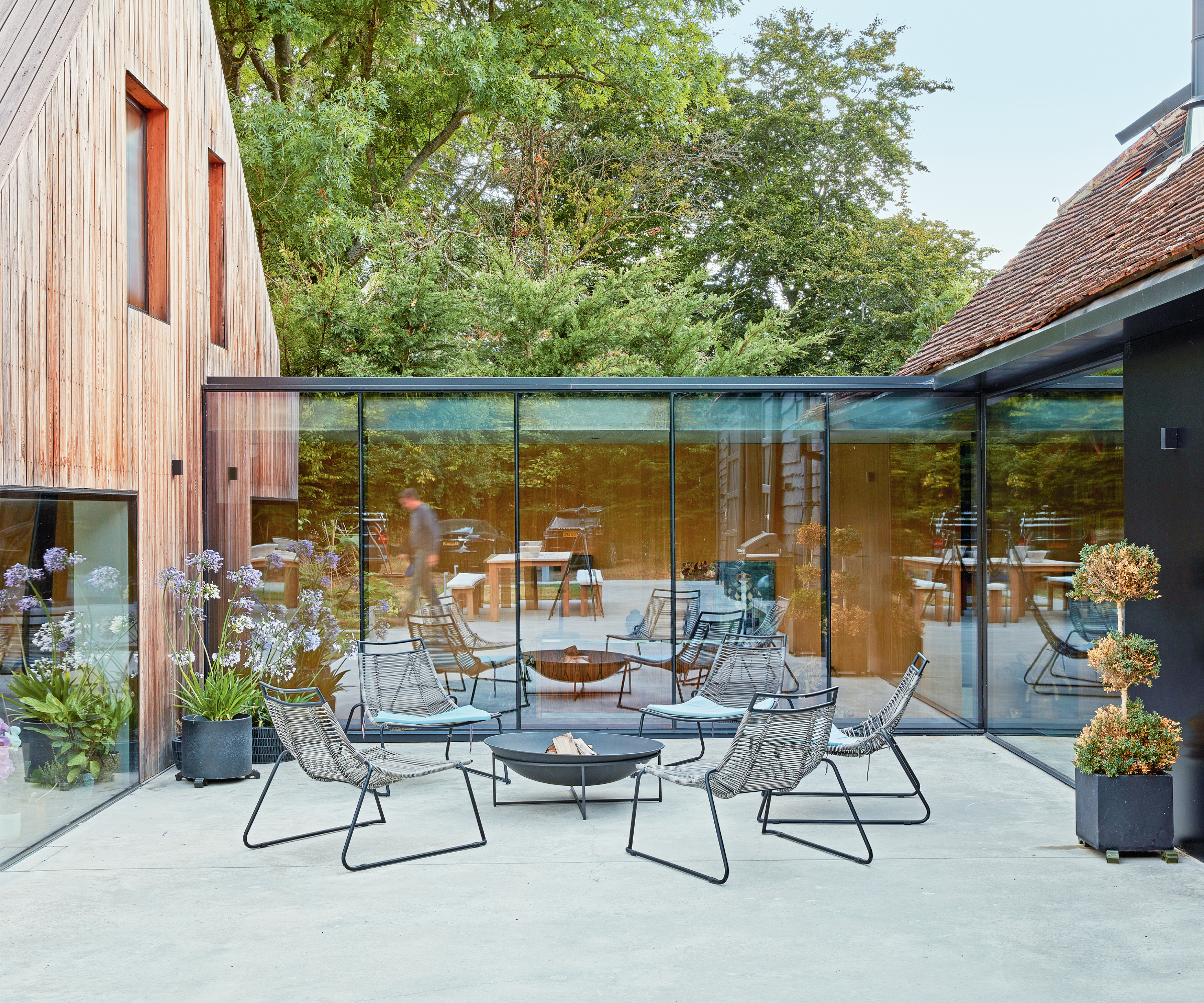
Different patio material costs
One of the main factors that will determine how much a patio costs is the materials used to form the space, although this is certainly not the only cost you will need to think about.
"One of the biggest misconceptions when it comes to laying a new patio or driveway, is that the materials are the most expensive part, when in fact 80% of the cost is made up of the sub-base and ground preparation," say the patio experts at Marshalls. "This means that if you want to go for premium quality paving, it won’t significantly increase the overall project cost."
Although you are likely to step into this project with plenty of garden paving ideas in mind, it is essential you understand the cost of patio materials at the outset to avoid disappointment.
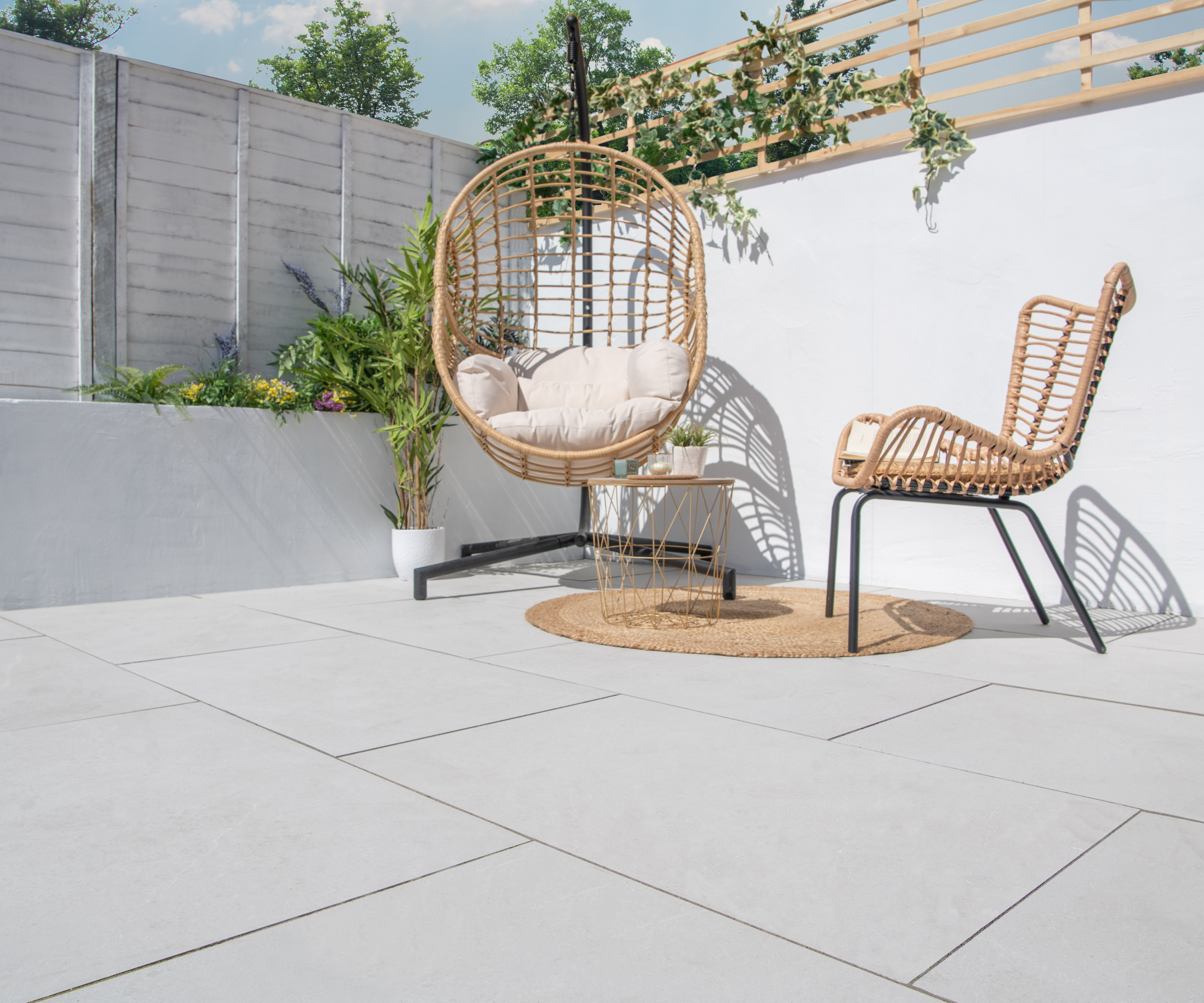
1. Concrete paving costs
Although concrete is often overlooked, it's well worth considering concrete paving ideas. As well as being reasonably priced and practical it's also available in a wide variety of forms, some of which are excellent at imitating the look of materials like real stone.
Basic concrete slabs start at £20/m2. If you want a good-quality product that mimics the appearance of natural materials, your budget should allow for costs closer to £50/m2 and up to £80/m2.
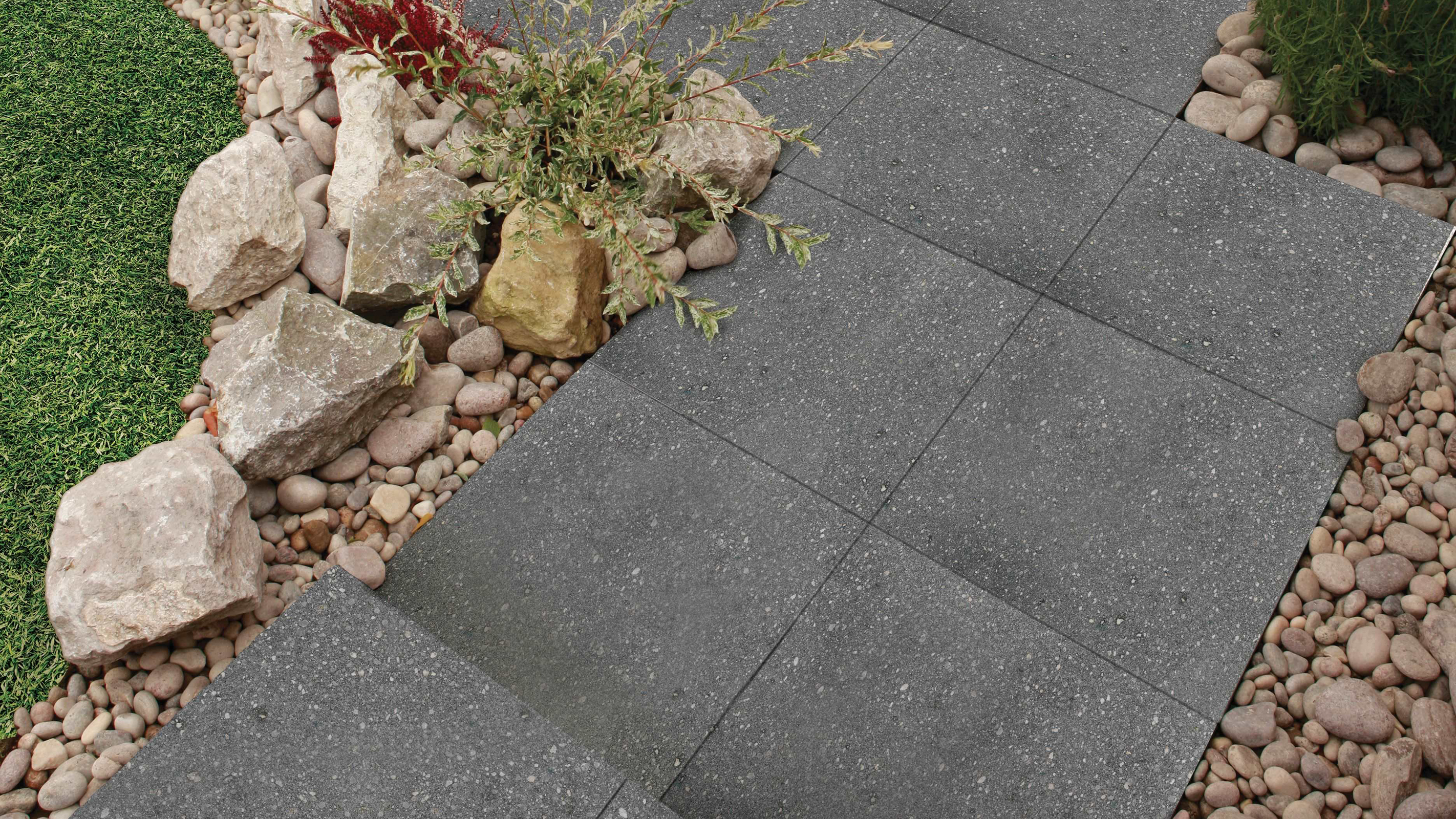
2. Porcelain paving costs
While it's necessary to consider porcelain paving pros and cons, the former clearly outweighs the latter. Despite the fact that porcelain is typically more expensive than other materials, it is easy to see why so many people want to use it for their patio.
It absorbs less moisture than other materials and so keeps clean longer, is strong and durable and is also less prone to cracking.
Porcelain’s appearance reflects its value on completion and it will enhance any patio. The typical price range for porcelain paving is from £40/m2 to £80/m2.
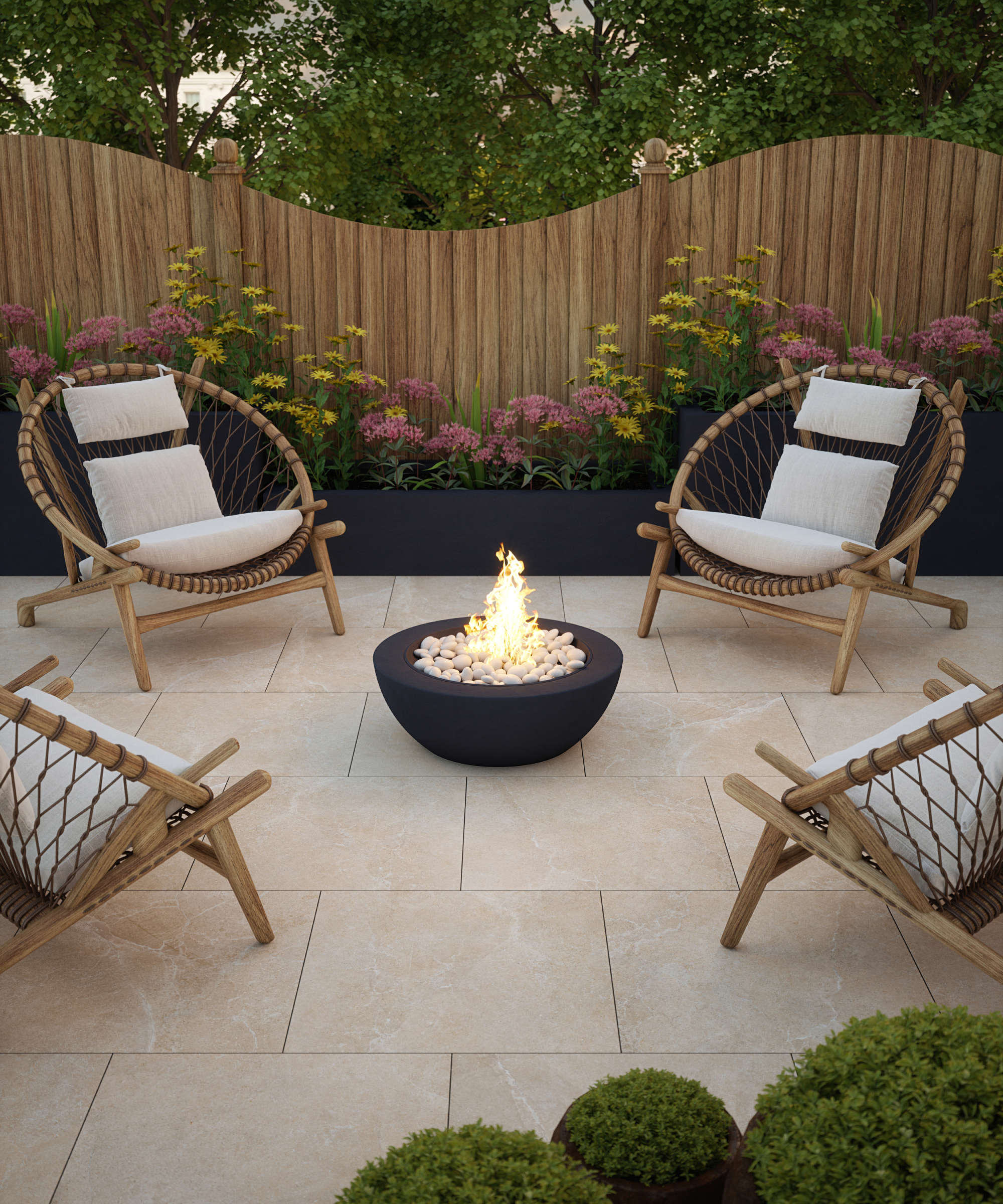
3. Natural stone patio costs
Natural stone is one of the most expensive materials for patios. Indian Sandstone can be purchased for as little as £40/m2 but can easily reach over £100/m2. Granite paving ranges from about £30/m2 to more than £100/m2 for premium quality pavers. The cost of limestone starts at about £25/m2, with more aesthetically pleasing paving likely to cost £50/m2 or more. Your exact choice of stone, as well as the quality and design will dictate the final costs.
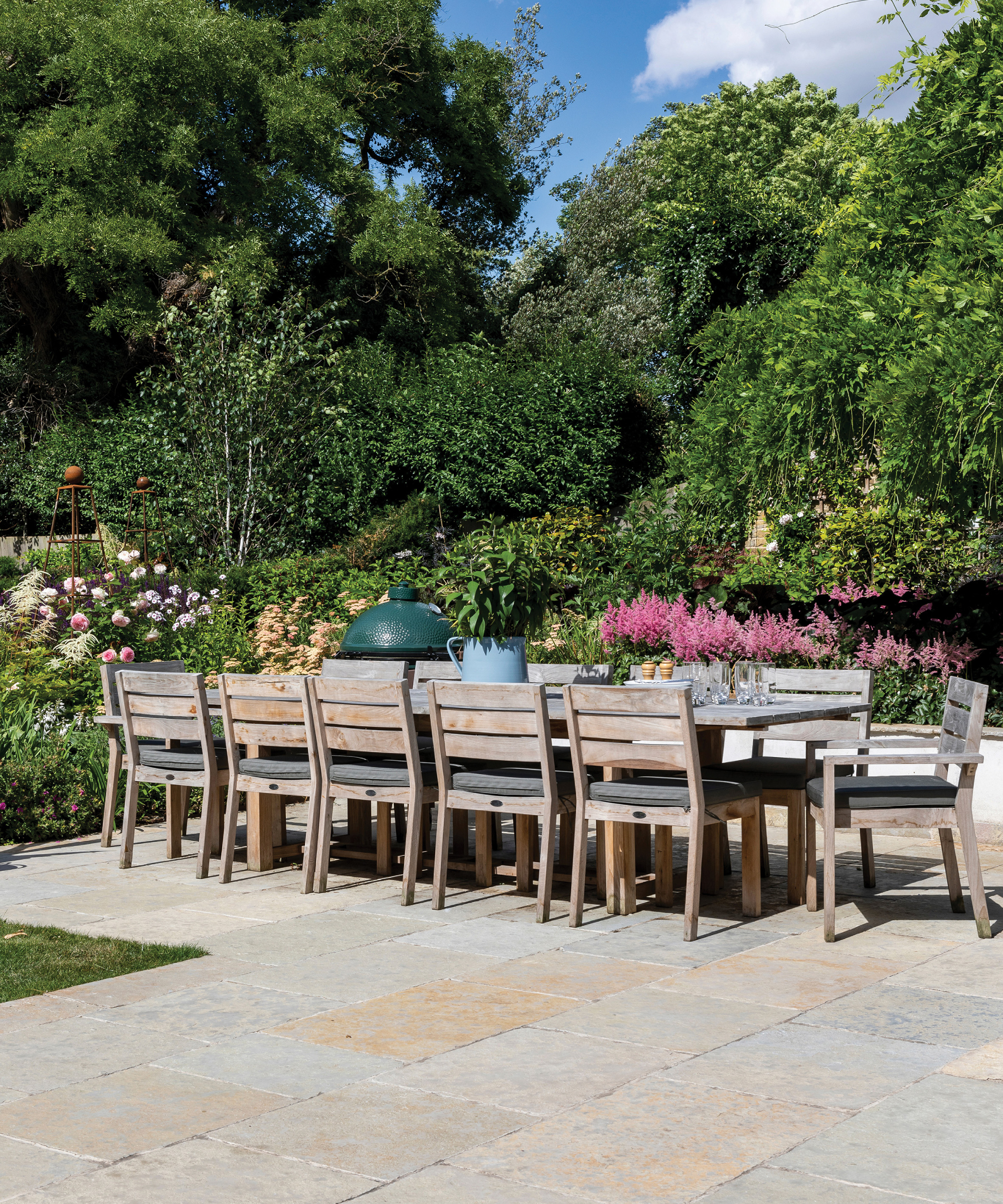
4. Decking costs
Are you trying to decide between a patio or decking? Or perhaps you want to infill part of a patio with a decked area. If this is the case, then you will undoubtedly be wondering how much a timber deck costs.
In general, decking can cost anywhere between £40 and £150/m2. Hardwood decking such as Hardwood Yellow Balau, can cost up to £100/m2 for supply only, while entry-level softwood decking can cost as little as £22/m2.
Composite decking, a common substitute for wood will cost £38/m2 on average with some premium PVC decking costing approximately £70/m2.
Remember to allow for redecoration costs for timber decking using decking oil or stain. You should always request a quote from a reputable decking installer or carpenter to get a more precise idea of the cost for your particular project.
| Softwood | £22 |
| Composite | £38 |
| Premium PVC | £70 |
| Hardwood (Yellow Balau) | £92 |
| Aluminium | £144 |
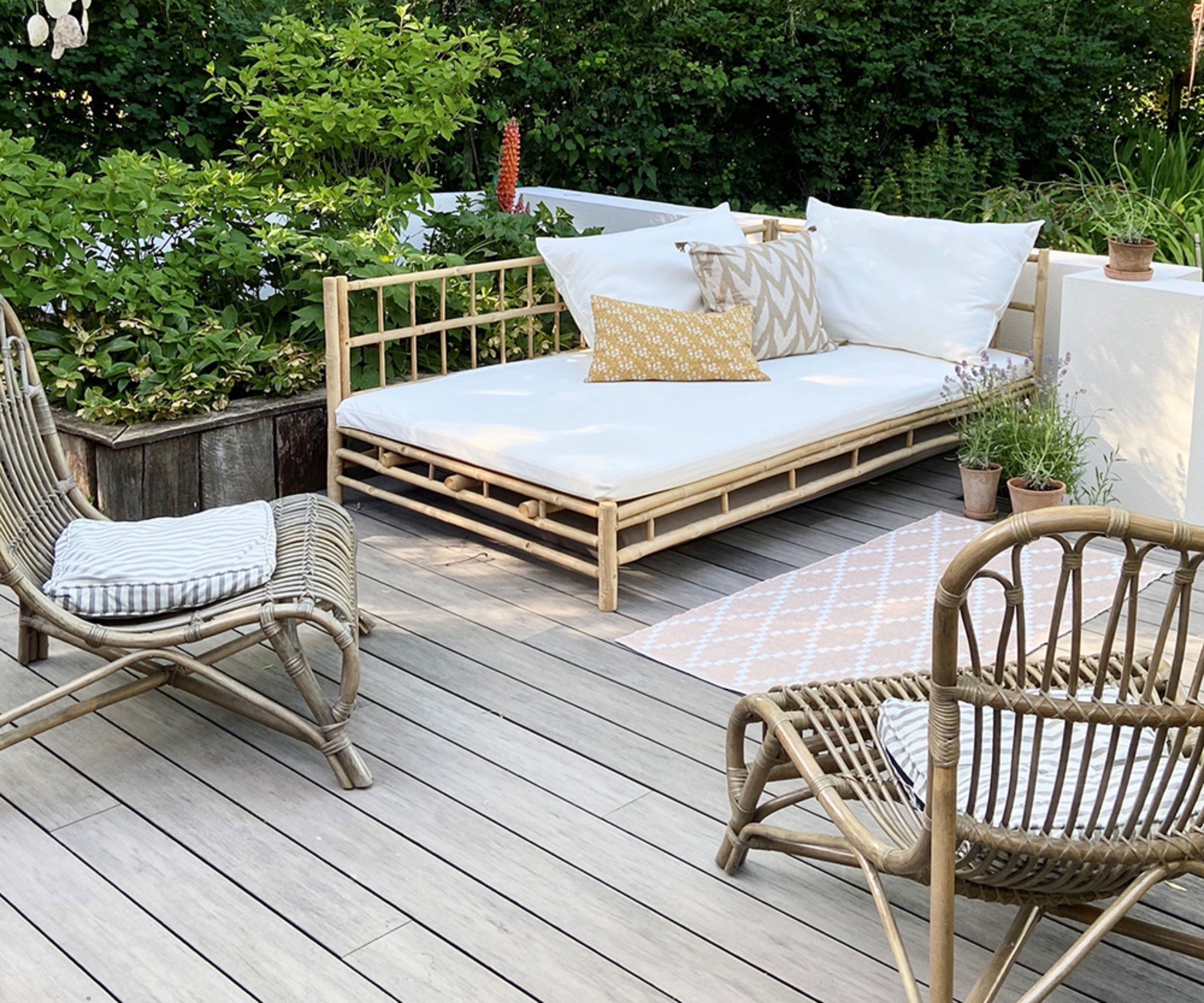
5. Brick paving costs
Brick pavers can add so much charm and character to a patio space, with reclaimed and blue bricks looking particularly beautiful. But installing a brick patio can be labour-intensive, and recycled materials can also be expensive. Costs are expected to start at £32/m2 and go up to £100/m2, depending on the bricks you select and whether you choose to lay them yourself.
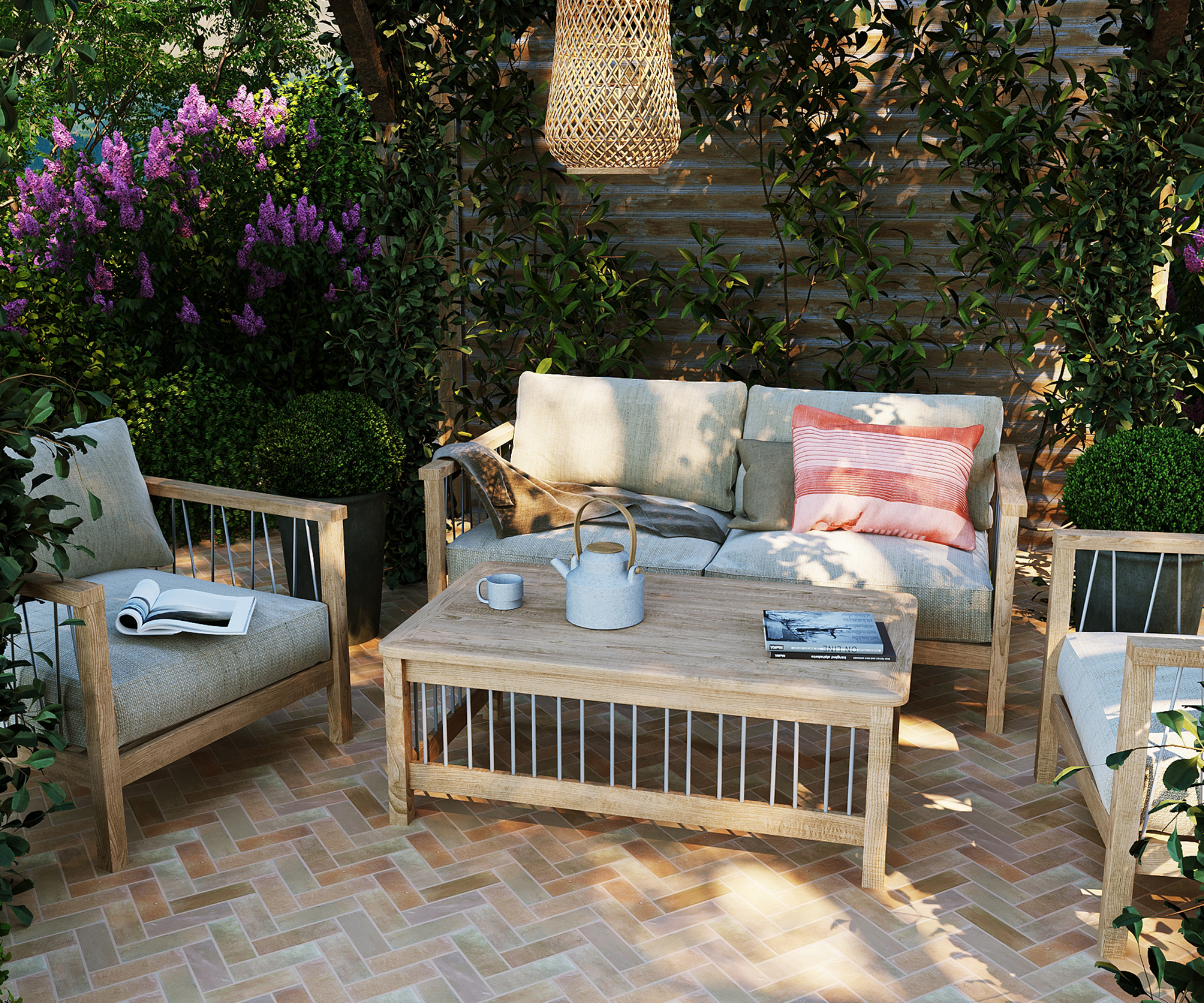
6. Natural slate costs
Slate makes an ideal material for use in your patio. Available in calibrated 20mm thickness and designed for outdoors, it provides excellent aesthetic performance and is available in a range of shades and sizes. It also has a natural anti-slip property while retaining a soft feel. Brazilian Natural slate will start from around £45/m2.
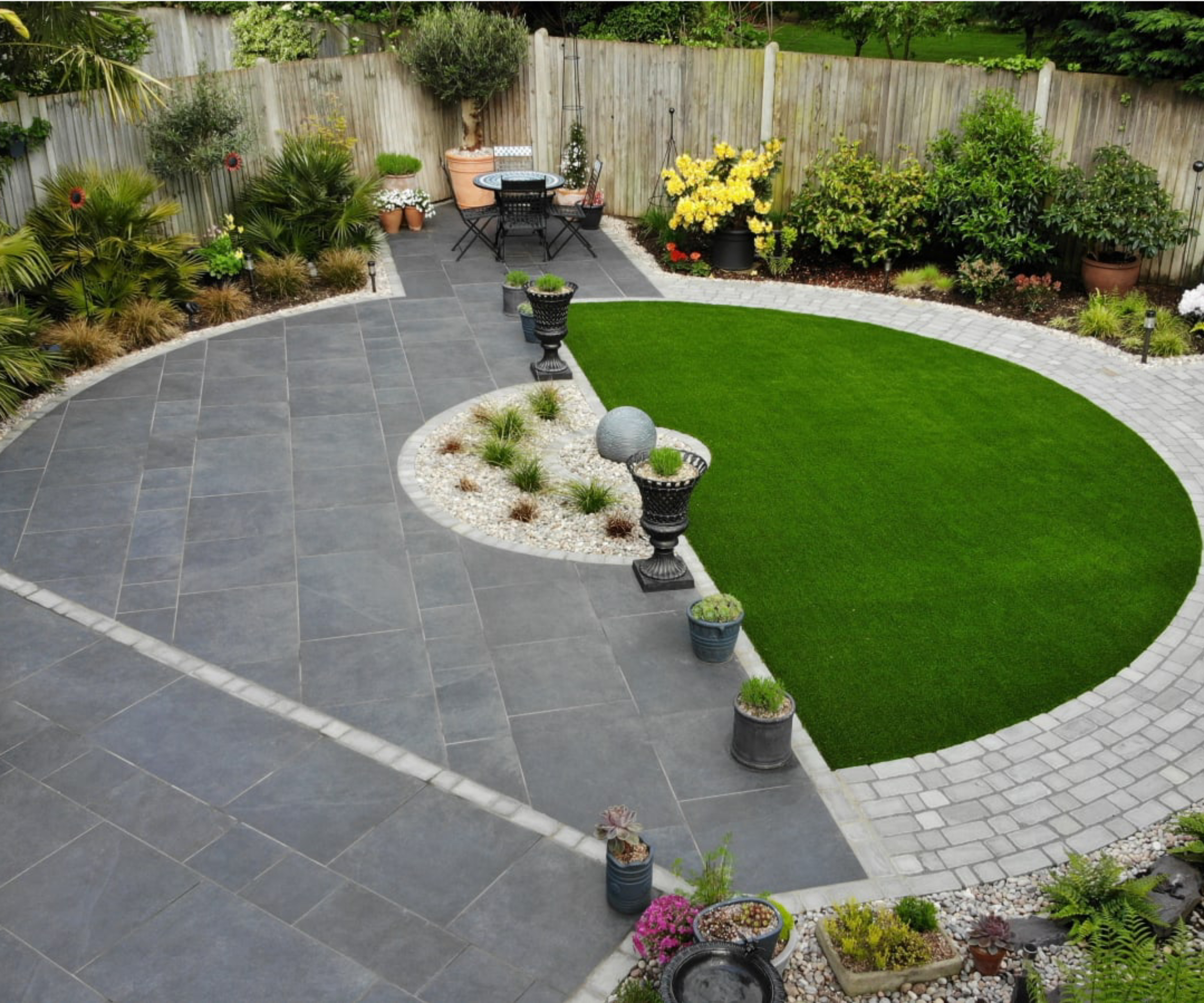
7. Additional costs
As well as the main material costs, remember to budget for additional items to complete the job such as external grout - try this Glean patio grout from Amazon priced at £39.99 for 15kg and the right colour enhancer and stain protector for your patio such as this StoneCare4u All Stone Sealer and colour enhancer for at £56.95 for 5 liters .
If you're using a suspended system of large format outdoor tiles that don't require adhesives or grout, you'll also need adjustable support pedestals priced at around £5.49 each.
You may also be considering patio lighting ideas so don't forget to factor in the cost for an electrician, or if you are keen to make use of your space all year round, make sure you've decided on your patio cover ideas as this may affect your materials and groundworks.
Installation and labour costs
Like a house, a patio is constructed on solid foundations made from a stone sub-base and sand. So even if you decide on DIY patio installation, it is important to make sure that the ground is adequately prepared and that a solid sub-base is laid first.
If you decide to call in a professional to lay your patio, a landscape gardener or bricklayer might well be your first port of call.
Groundworkers and bricklayers often charge between £150 and £250 per day, whereas landscape gardeners typically charge between £100 and £150 per day. If they need a labourer, they charge about £100 per day.
It typically takes four to five days to lay the average patio size of around 40-50m2.
Additionally, there are a few frequently disregarded elements, such as drainage, that could increase the total cost of your patio.
"Drainage is one of the less glamorous aspects of a new patio, however it’s still an important one as you don’t want to damage the foundations of your home," say Marshalls' patio experts. "A professional will be able to offer advice from laying a sub-base and the gradient of the patio to the possible installation of drainage channels.
"Hidden pipes and cables underneath your existing garden can add additional costs to your patio too," they continue. "They should be buried at sufficient depth in relation to the patio. Any additional removals such as trees, walls and flowerbeds will affect the overall price so it’s something to consider at the start."
Patio maintenance costs
For a patio to remain functional as well as attractive, regular maintenance is essential - all of which need to be considered when it comes to calculating your patio costs.
Regardless of the material used, sweeping, using the best pressure washer or cleaning with appropriate chemicals, should take place on a regular basis. Depending on the size of your patio you may choose to do this yourself or hire in a professional.
To prevent ageing, staining and colour fading, certain patio materials also benefit from routine sealing. Cracks, chipping, or uneven surfaces may also develop over time as a result of weathering and general wear and tear and need repair.
In order to minimise extra costs, it's therefore worth considering how long the materials you’ve chosen for the patio will last. Different materials have differing degrees of resilience.
For example, with the correct maintenance, a concrete patio can survive for decades, whereas if you're wondering how long does decking last, the fact is it will need more frequent maintenance and ultimately need to be replaced sooner.
FAQs
Can I re-use existing materials?
If you're renovating an outdated patio or building a new one, salvaging and reusing any of the existing materials or any other natural materials you may have in your garden can be a way of reducing patio costs.
As well as lowering the inital outlay for new materials, it also minimises disposal costs. And it doesn't just have to be slabs from an existing patio area. Leftover stone walling or timbers can be used as for patio edging ideas and add charm to your overall design as well as lowering your budget. Alternatively, you could consider painting patio slabs instead as a quick and cost-effective update.
How do I get the best prices?
It's key to shop around when it comes to sourcing your patio materials and professional installers.
Request quotes from a number of merchants and contractors and don't feel you need to buy everything from the same merchant. It's a competitive market at the moment so don't be afraid to haggle or request discounts.
Bank Holiday sales are also worth waiting for with a potential extra 25% off making a decent impact on your patio costs.
If you're considering using the same tiles inside and out create a continuous floor finish keep in mind that tiles used outdoors must also be frost proof, weather-resistant and have additional slip resistance so that they won't be a hazard in wet conditions. Ensure that the grout is also in the same colour and you allow for a flush threshold with a recessed base track and frame. This will make stepping in and out and the placement of furniture a more streamlined affair.
Don't forget you can also consider eco-friendly options for your patio such as permeable paving materials that allow water to drain through or timber decking that is sourced sustainably.
And finally, make sure you speak to your Local Authority to confirm whether any planning permission for decking or Building Regulations are required for your patio project.
Get the Homebuilding & Renovating Newsletter
Bring your dream home to life with expert advice, how to guides and design inspiration. Sign up for our newsletter and get two free tickets to a Homebuilding & Renovating Show near you.
Natasha was Homebuilding & Renovating’s Associate Content Editor and was a member of the Homebuilding team for over two decades. In her role on Homebuilding & Renovating she imparted her knowledge on a wide range of renovation topics, from window condensation to renovating bathrooms, to removing walls and adding an extension. She continues to write for Homebuilding on these topics, and more. An experienced journalist and renovation expert, she also writes for a number of other homes titles, including Homes & Gardens and Ideal Homes. Over the years Natasha has renovated and carried out a side extension to a Victorian terrace. She is currently living in the rural Edwardian cottage she renovated and extended on a largely DIY basis, living on site for the duration of the project.

